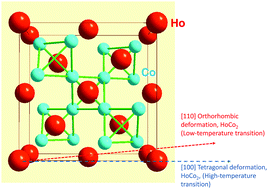Balancing structural distortions via competing 4f and itinerant interactions: a case of polymorphism in magnetocaloric HoCo2†
Abstract
The nature of multiple magnetostructural transformations in HoCo2 has been studied by employing magnetic and specific heat measurements, temperature and magnetic field dependent X-ray powder diffraction, and first-principles calculations. Unexpected increase of magnetization observed below the spin-reorientation temperature (TSR) suggests that the low-temperature transition involves a reduction of Co moment. First principles calculations confirm that the paramagnetic cubic to ferrimagnetic tetragonal transformation at TC is assisted by itinerant electron metamagnetism, and that the reduction of Co moment in HoCo2 occurs in parallel with the ferrimagnetic tetragonal to the nearly ferromagnetic orthorhombic transformation at TSRvia the rearrangement of both 3d states of Co and 5d states of Ho. The ac magnetic susceptibility measurements show significant magnetic frustration below TC. In contrast to earlier reports neither ac nor dc magnetic susceptibilities show anomalies in the paramagnetic region obeying the Curie–Weiss law.


 Please wait while we load your content...
Please wait while we load your content...